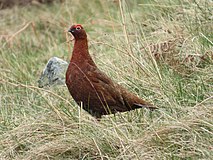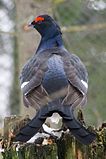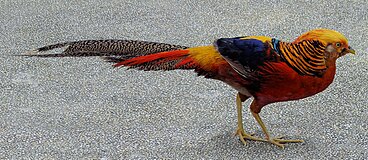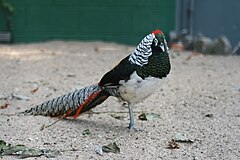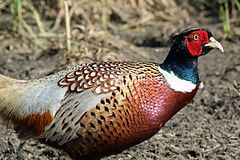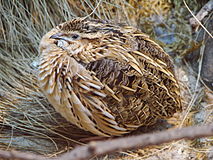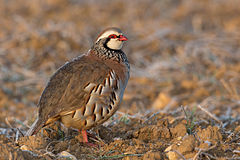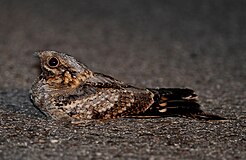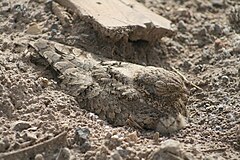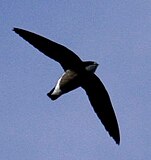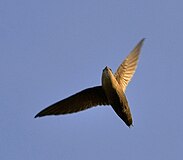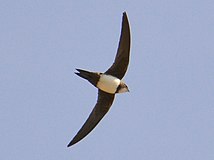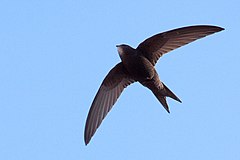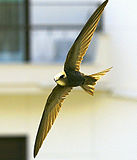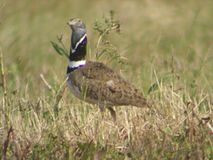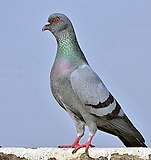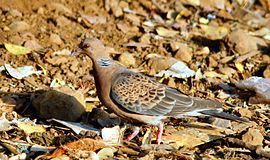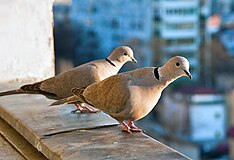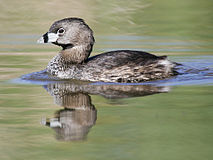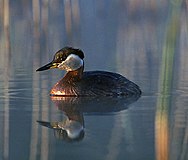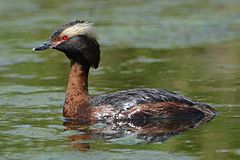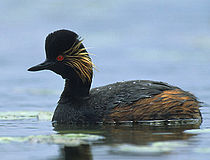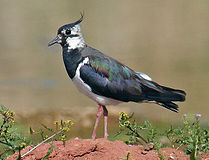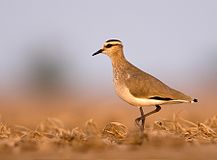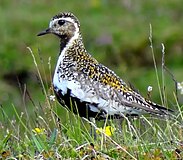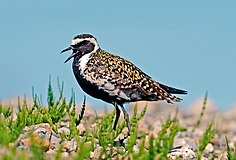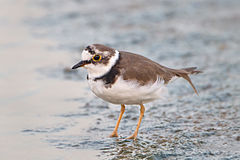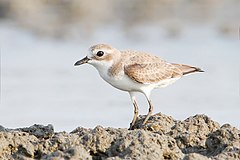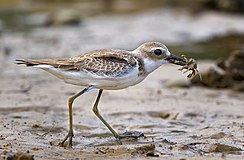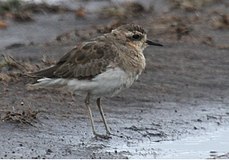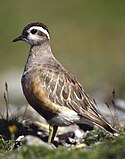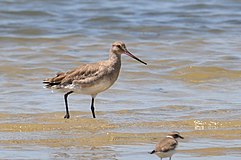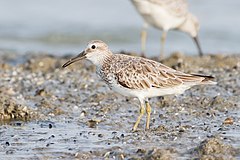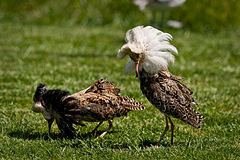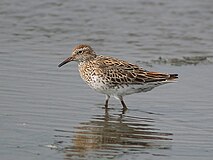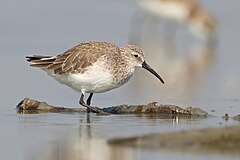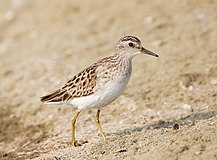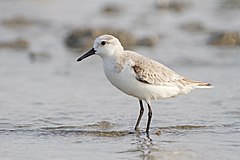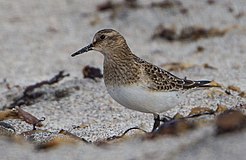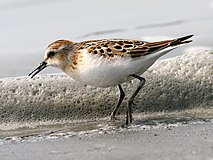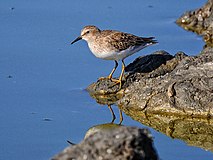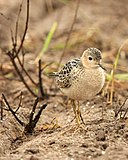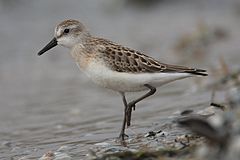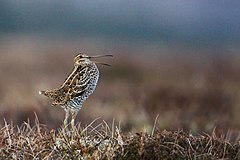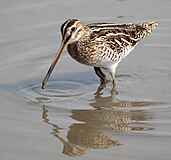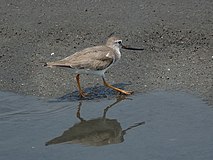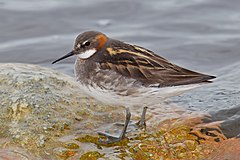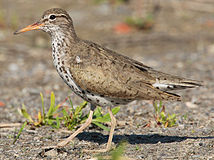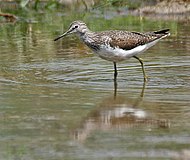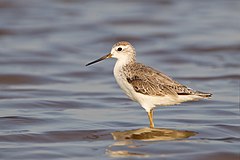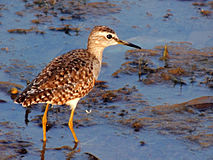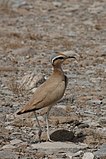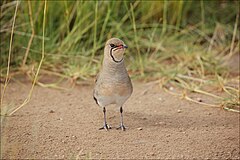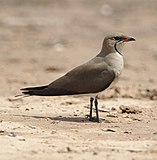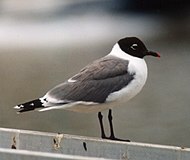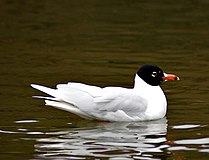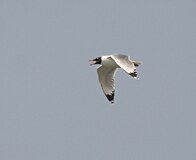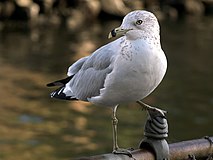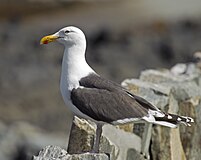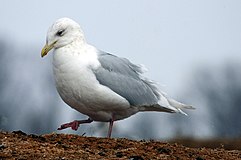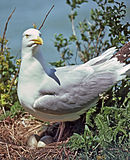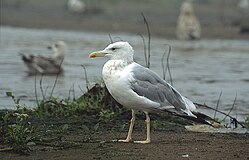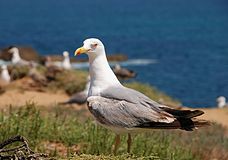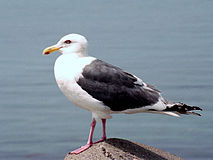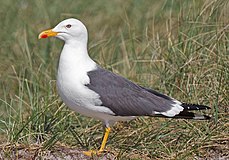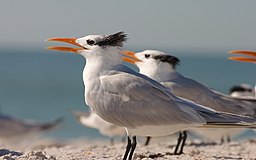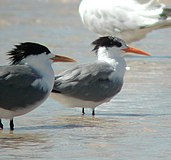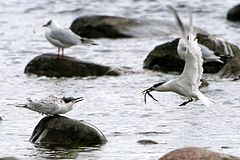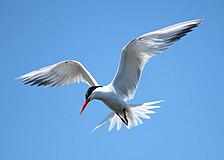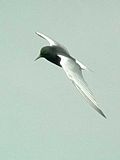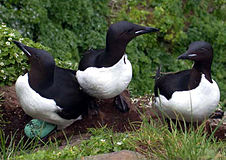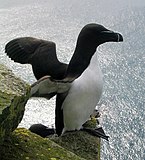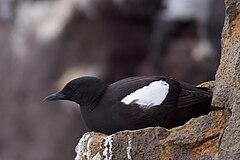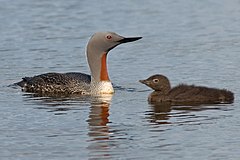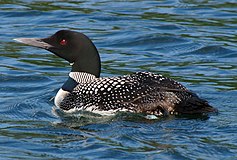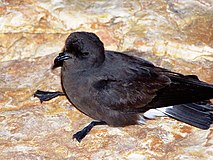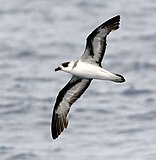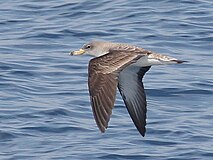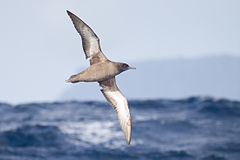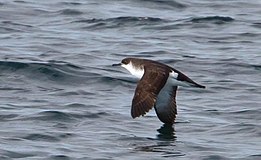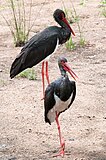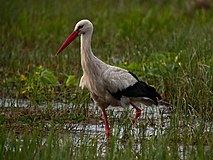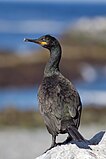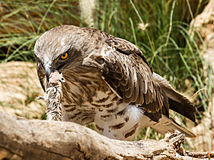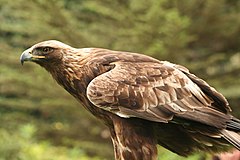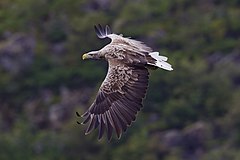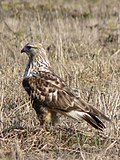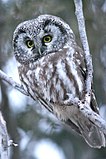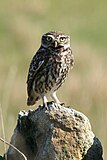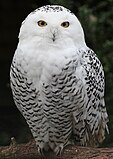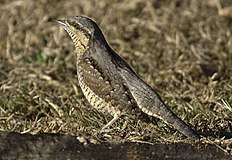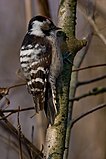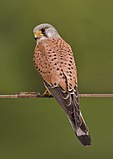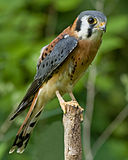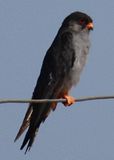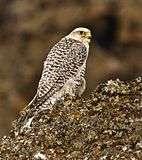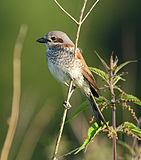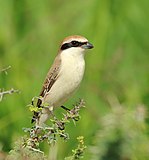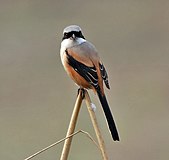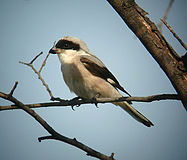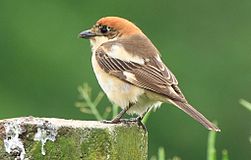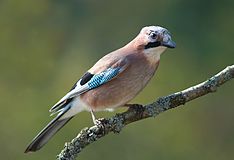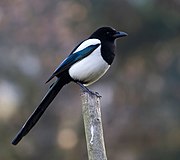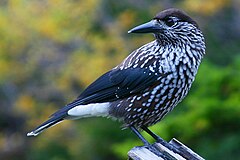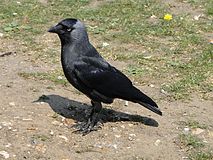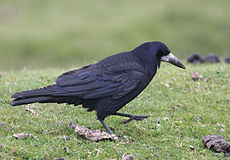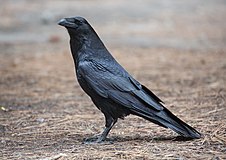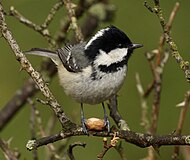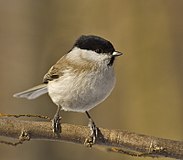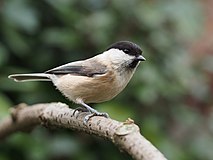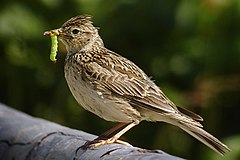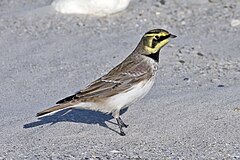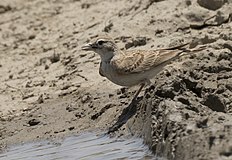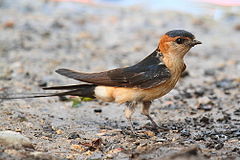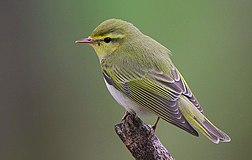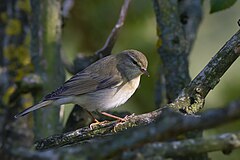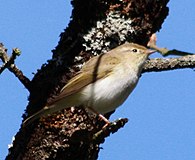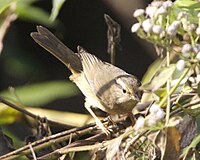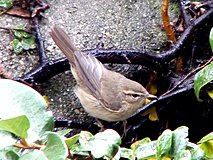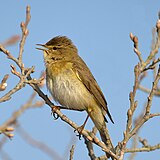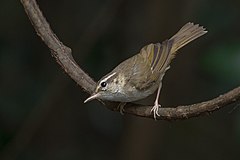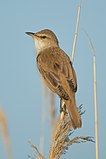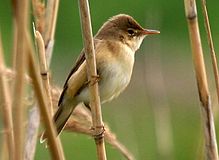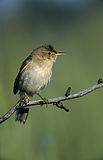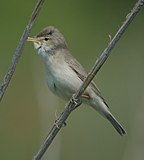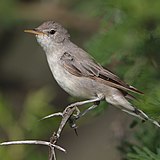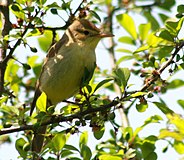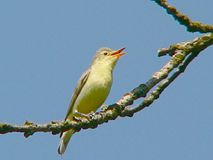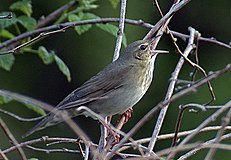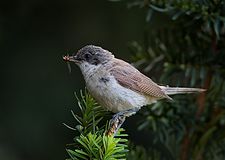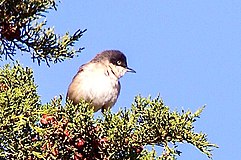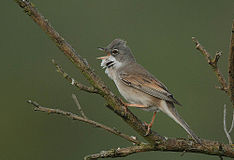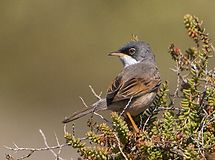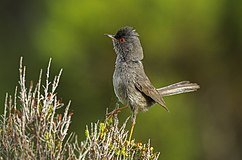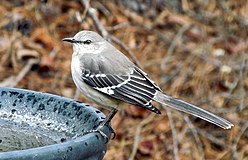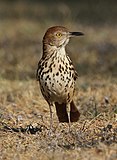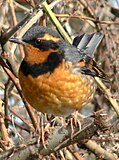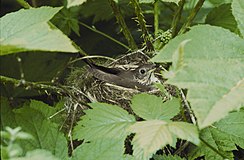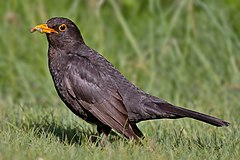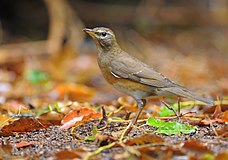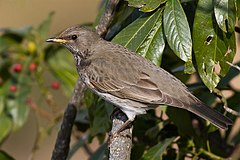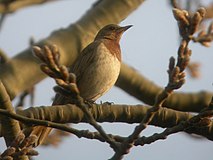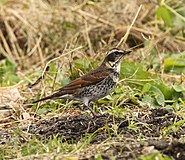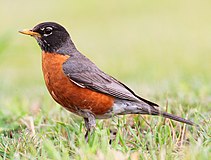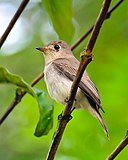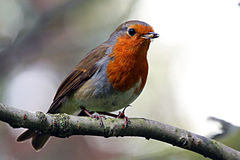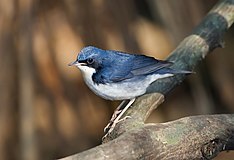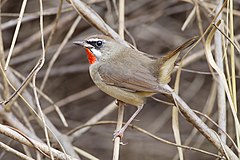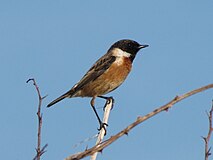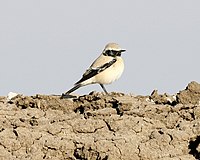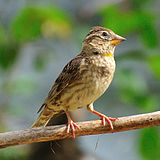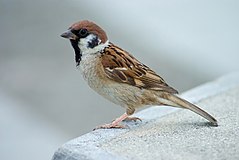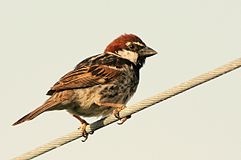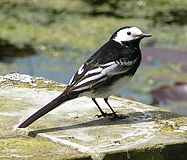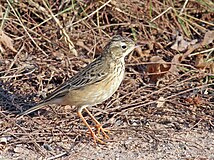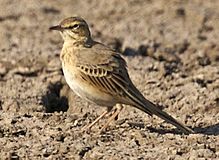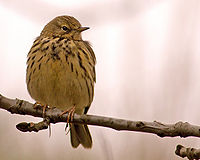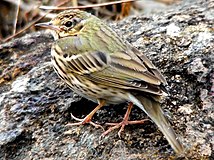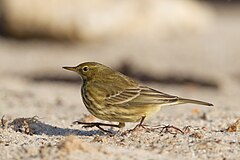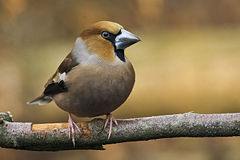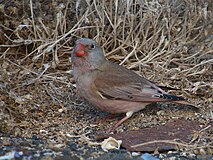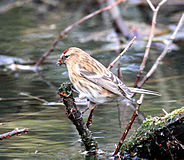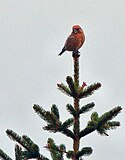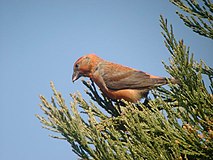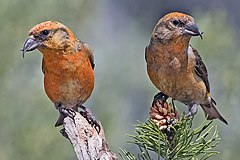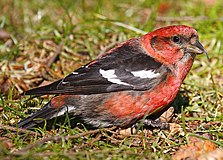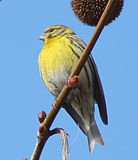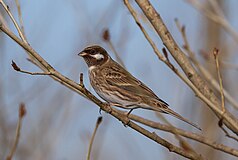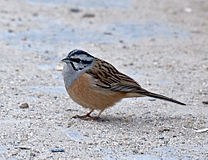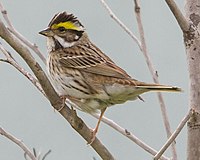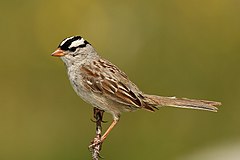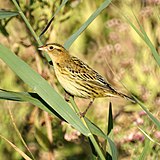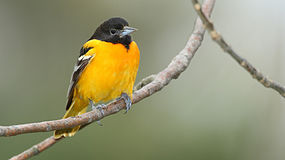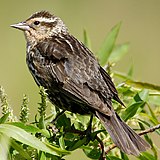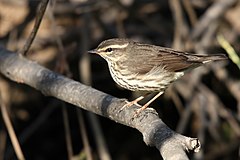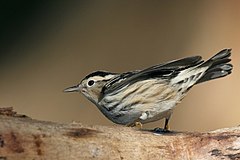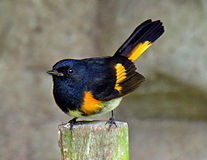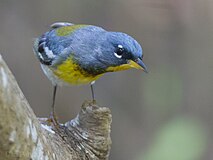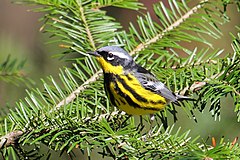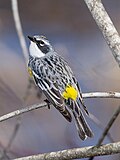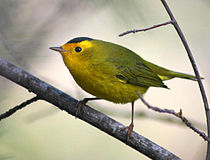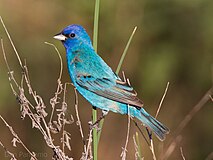bio.wikisort.org - Animal
This list of birds of Great Britain comprises all bird species that have been recorded in a wild state in Great Britain. It follows the official British List, maintained by the British Ornithologists' Union (BOU).[1] Decisions relating to the British List are published by the British Ornithologists' Union Records Committee (BOURC) in its annual reports in the BOU's journal Ibis. These reports were formerly geographically based and included the whole of the British Isles, but records for the Republic of Ireland and Northern Ireland are now published by their own ornithological associations. Records from the Isle of Man are adjudicated by the Manx Ornithological Society.[2]
Bird species admitted to the British List are those in BOU categories A, B or C:
- A: species that have been recorded in an apparently natural state at least once since 1 January 1950.
- B: species that were recorded in an apparently natural state at least once between 1 January 1800 and 31 December 1949, but have not been recorded subsequently.
- C: species that, although originally introduced by humans, either deliberately or accidentally, have established breeding populations derived from introduced stock, which maintain themselves without necessary recourse to further introduction.
Birds can be listed in more than one category: for example the Canada goose has a large introduced population but there have also been a few naturally occurring vagrants, so it meets the criteria for both categories A and C.
Categories D and E (not listed here) are used for record keeping only, and species in these categories are not included in the British List:
- D: species that would otherwise appear in categories A or B except that there is reasonable doubt that they have ever occurred in a natural state.
- E: species that have been recorded as introductions, transportees, or escapees from captivity, and whose breeding populations (if any) are not believed to be self-sustaining.
A further category (not listed here) is being compiled:
- F: species recorded before 1800, including fossil species.[3]
As of 30 June 2021, there are 626 species of birds on the British List,[4] the latest addition being the white-chinned petrel.[5] Four species groups (birds that were not identified to species level) are included in an appendix – southern/northern giant petrel (Macronectes giganteus/halli), Fea's/Desertas petrel (Pterodroma feae/desertas), Black-bellied/White-bellied Storm Petrel (Fregetta tropica/grallaria), and Brown/South Polar skua (Stercorarius antarctica/maccormickii). Six further species are awaiting consideration by the British Ornithologists' Union Records Committee.
Species listed on this page as "rare" are those for which a full description is required for acceptance of the record by the British Birds Rarities Committee. Other species have an indication of their breeding and wintering status in Great Britain.
In general the avifauna of Britain is similar to that of the rest of Europe. Because of its mild winters, Great Britain has a considerable population of wintering species, particularly ducks, geese and swans. There are also a number of species, such as the oystercatcher, that are resident on the island of Great Britain, but migrants elsewhere. Britain receives a number of vagrants from Asia and North America. Some American gulls, ducks and waders are regular enough not to be considered rare, including the ring-billed gull, surf scoter and pectoral sandpiper. There is one endemic bird species found in Great Britain: the Scottish crossbill.
Ducks, geese, and swans
Order: Anseriformes Family: Anatidae
The swans, ducks and geese are medium to large birds that are adapted to an aquatic existence with webbed feet and bills which are flattened to a greater or lesser extent. In many ducks the male is colourful while the female is dull brown. The diet consists of a variety of animals and plants. The family is well represented in Britain, especially in winter when large numbers visit from Greenland, Scandinavia and Russia.
| Common and binomial names | Image | Status |
|---|---|---|
| Brent goose (Branta bernicla) |  | A winter visitor |
| Red-breasted goose (Branta ruficollis) | 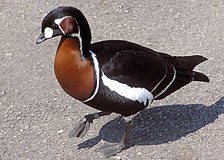 | A rare vagrant |
| Canada goose (Branta canadensis) | 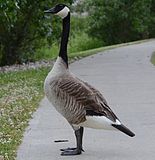 | A & C resident introduced population, some wild vagrants |
| Barnacle goose (Branta leucopsis) | 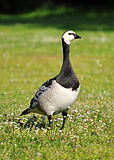 | A & C winter visitor and resident introduced population |
| Cackling goose (Branta hutchinsii) |  | A rare vagrant |
| Ross's goose (Anser rossii) |  | A rare vagrant[6] |
| Snow goose (Anser caerulescens) |  | A & C resident introduced population, some wild vagrants |
| Greylag goose (Anser anser) |  | A & C resident wild and feral populations, winter visitor |
| Taiga bean goose (Anser fabalis) |  | A winter visitor |
| Pink-footed goose (Anser brachyrhynchus) |  | A winter visitor |
| Tundra bean goose (Anser serrirostris) |  | A winter visitor |
| White-fronted goose (Anser albifrons) |  | A winter visitor |
| Lesser white-fronted goose (Anser erythropus) | 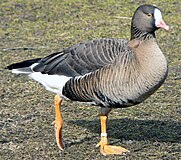 | A rare vagrant |
| Mute swan (Cygnus olor) | 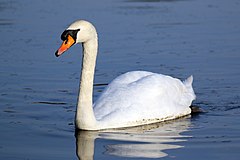 | A & C resident breeding species |
| Bewick's swan (Cygnus columbianus) |  | A winter visitor |
| Whooper swan (Cygnus cygnus) |  | A winter visitor and occasional breeder |
| Egyptian goose (Alopochen aegyptiaca) |  | C resident introduced population |
| Shelduck (Tadorna tadorna) |  | A resident breeder and winter visitor |
| Ruddy shelduck (Tadorna ferruginea) |  | B Records since 1946 are presumed escapes from captivity |
| Mandarin duck (Aix galericulata) |  | C resident introduced population |
| Baikal teal (Sibirionetta formosa) |  | A rare vagrant |
| Garganey (Spatula querquedula) | 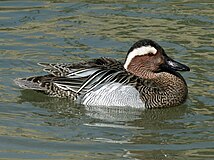 | A breeding summer visitor |
| Blue-winged teal (Spatula discors) | 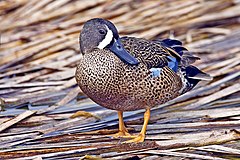 | A rare vagrant |
| Shoveler (Spatula clypeata) |  | A resident breeder and winter visitor |
| Gadwall (Mareca strepera) |  | A & C resident breeder and winter visitor |
| Falcated duck (Mareca falcata) |  | A rare vagrant |
| Wigeon (Mareca penelope) |  | A resident breeder and winter visitor |
| American wigeon (Mareca americana) | 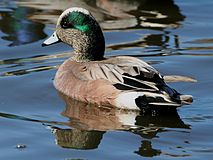 | A scarce migrant |
| Mallard (Anas platyrhynchos) | 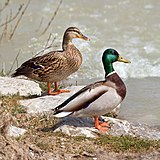 | A & C resident breeder, winter visitor and naturalised releases |
| Black duck (Anas rubripes) | 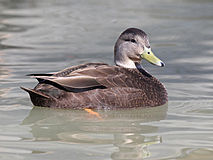 | A rare vagrant |
| Pintail (Anas acuta) |  | A resident breeder and winter visitor |
| Teal (Anas crecca) |  | A resident breeder and winter visitor |
| Green-winged teal (Anas carolinensis) | 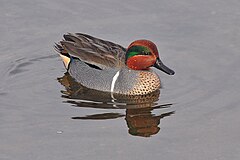 | A scarce migrant |
| Red-crested pochard (Netta rufina) |  | A & C scarce migrant and introduced breeder |
| Canvasback (Aythya valisineria) | 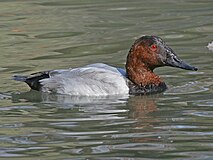 | A rare vagrant |
| Redhead (Aythya americana) |  | A rare vagrant |
| Pochard (Aythya ferina) |  | A resident breeder and winter visitor |
| Ferruginous duck (Aythya nyroca) |  | A scarce migrant |
| Ring-necked duck (Aythya collaris) |  | A scarce migrant |
| Tufted duck (Aythya fuligula) |  | A resident breeder and winter visitor |
| Scaup (Aythya marila) |  | A winter visitor and occasional breeder |
| Lesser scaup (Aythya affinis) |  | A rare vagrant |
| Steller's eider (Polysticta stelleri) | 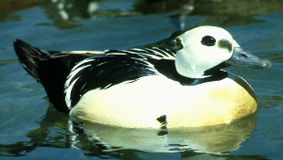 | A rare vagrant |
| King eider (Somateria spectabilis) |  | A rare vagrant |
| Eider (Somateria mollissima) | 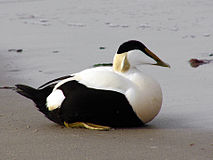 | A resident breeder and winter visitor |
| Harlequin duck (Histrionicus histrionicus) |  | A rare vagrant |
| Surf scoter (Melanitta perspicillata) |  | A scarce migrant |
| Velvet scoter (Melanitta fusca) | 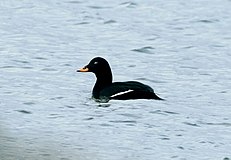 | A winter visitor |
| White-winged scoter (Melanitta deglandi) |  | A rare vagrant |
| Common scoter (Melanitta nigra) | 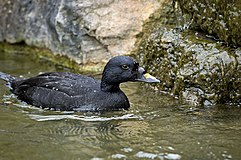 | A resident breeder and winter visitor |
| Black scoter (Melanitta americana) | 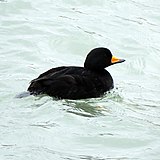 | A rare vagrant |
| Long-tailed duck (Clangula hyemalis) |  | A winter visitor and occasional breeder |
| Bufflehead (Bucephala albeola) |  | A rare vagrant |
| Goldeneye (Bucephala clangula) |  | A resident breeder and winter visitor |
| Barrow's goldeneye (Bucephala islandica) | 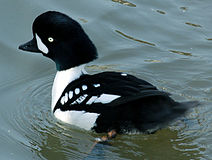 | A rare vagrant |
| Smew (Mergellus albellus) | 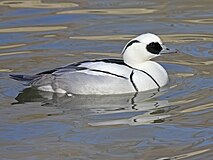 | A winter visitor |
| Hooded merganser (Lophodytes cucullatus) |  | A rare vagrant |
| Goosander (Mergus merganser) |  | A resident breeder and winter visitor |
| Red-breasted merganser (Mergus serrator) |  | A resident breeder and winter visitor |
| Ruddy duck (Oxyura jamaicensis) | 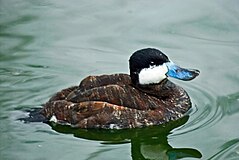 | C: introduced species currently subject to an eradication programme |
Pheasants, grouse, and allies
Order: Galliformes Family: Phasianidae
These are terrestrial species, feeding and nesting on the ground. They are variable in size but generally plump, with broad and relatively short wings. Four of these were introduced for hunting or ornamental purposes but one has now apparently died out.
Nightjars and allies
Order: Caprimulgiformes Family: Caprimulgidae
Nightjars are medium-sized nocturnal birds that usually nest on the ground. They have long wings, short legs and very short bills. Their soft plumage is cryptically coloured to resemble bark or leaves.
Swifts
Order: Apodiformes Family: Apodidae The swifts are small birds which spend the majority of their lives flying. These birds have very short legs and never settle voluntarily on the ground, perching instead only on vertical surfaces.
Bustards
Order: Otidiformes Family: Otididae
Large, sturdy birds of open plains with long legs and necks and strong feet. They are all rarities.
Cuckoos
Order: Cuculiformes Family: Cuculidae
Birds of variable size with slender bodies and long tails. Some species are known for laying their eggs in the nests of other birds.
Sandgrouse
Order: Pterocliformes Family: Pteroclidae
Sturdy, medium-sized birds with a small head and long, pointed wings.
| Common and binomial names | Image | Status |
|---|---|---|
| Pallas's sandgrouse (Syrrhaptes paradoxus) | 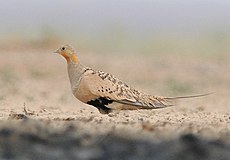 | A rare vagrant, has bred |
Pigeons and doves
Order: Columbiformes Family: Columbidae
Pigeons and doves are stout-bodied birds with short necks and short slender bills with a fleshy cere. There are 344 species worldwide, seven in Britain.
Rails, gallinules, and coots
Order: Gruiformes Family: Rallidae
These birds mainly occupy dense vegetation in damp environments near lakes, marshes or rivers. Many are shy and secretive birds, making them difficult to observe. Most species have strong legs and long toes which are well adapted to soft uneven surfaces.
| Common and binomial names | Image | Status |
|---|---|---|
| Water rail (Rallus aquaticus) |  | A resident breeding species |
| Corncrake (Crex crex) | 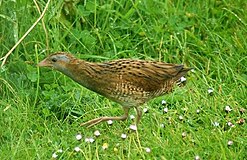 | A breeding summer visitor |
| Sora rail (Porzana carolina) | 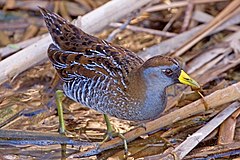 | A rare vagrant |
| Spotted crake (Porzana porzana) | 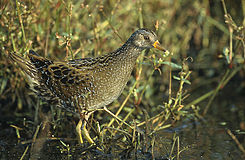 | A scarce breeding summer visitor |
| Moorhen (Gallinula chloropus) |  | A resident breeding species |
| Coot (Fulica atra) |  | A resident breeding species |
| American coot (Fulica americana) | 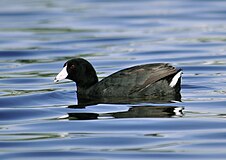 | A rare vagrant |
| Allen's gallinule (Porphyrio alleni) |  | A rare vagrant |
| American purple gallinule (Porphyrio martinicus) |  | A rare vagrant |
| Western swamphen[7] (Porphyrio porphyrio) |  | A rare vagrant, first recorded in 2016. |
| Baillon's crake (Zapornia pusilla) |  | A rare vagrant, formerly bred |
| Little crake (Zapornia parva) |  | A rare vagrant |
Cranes
Order: Gruiformes Family: Gruidae
Cranes are large, long-legged and long-necked birds. Unlike the similar-looking but unrelated herons, cranes fly with necks outstretched, not pulled back. Most have elaborate and noisy courting displays or "dances".
| Common and binomial names | Image | Status |
|---|---|---|
| Sandhill crane (Antigone canadensis) |  | A rare vagrant |
| Crane (Grus grus) |  | A resident breeding species and passage migrant |
Grebes
Order: Podicipediformes Family: Podicipedidae
Grebes are small to medium-large diving birds with lobed toes and pointed bills. They are seen mainly on lowland waters and coasts. They feed on aquatic animals and nest on a floating platform of vegetation.
Stone-curlews
Order: Charadriiformes Family: Burhinidae
A small family of medium to large waders with strong black bills, large yellow eyes and cryptic plumage.
| Common and binomial names | Image | Status |
|---|---|---|
| Stone curlew (Burhinus oedicnemus) | 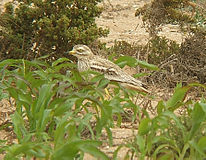 | A breeding summer visitor |
Oystercatchers
Order: Charadriiformes Family: Haematopodidae
The oystercatchers are large, obvious and noisy wading birds with strong bills used for smashing or prising open molluscs. There are eleven species worldwide with one in Britain.
| Common and binomial names | Image | Status |
|---|---|---|
| Oystercatcher (Haematopus ostralegus) |  | A resident breeding species |
Stilts and avocets
Order: Charadriiformes Family: Recurvirostridae
A family of fairly large wading birds. The avocets have long legs and long up-curved bills. The stilts have extremely long legs and long, thin, straight bills. There are ten species worldwide with two in Britain.
| Common and binomial names | Image | Status |
|---|---|---|
| Black-winged stilt (Himantopus himantopus) |  | A rare vagrant and occasional breeder |
| Avocet (Recurvirostra avosetta) |  | A resident breeding species |
Plovers and lapwings
Order: Charadriiformes Family: Charadriidae
Small to medium-sized wading birds with compact bodies, short, thick necks and long, usually pointed, wings.
Sandpipers and allies
Order: Charadriiformes Family: Scolopacidae
A large, diverse family of wading birds. Different lengths of legs and bills enable multiple species to feed in the same habitat, particularly on the coast, without direct competition for food.
Pratincoles and coursers
Order: Charadriiformes Family: Glareolidae
A family of slender, long-winged wading birds.
Gulls, terns, and skimmers
Order: Charadriiformes Family: Laridae
Medium to large seabirds with grey, white and black plumage, webbed feet and strong bills. Many are opportunistic and adaptable feeders.
Skuas
Order: Charadriiformes Family: Stercorariidae
Medium to large seabirds with mainly grey or brown plumage, sharp claws and a hooked tip to the bill. They chase other seabirds to force them to drop their catches.
| Common and binomial names | Image | Status |
|---|---|---|
| South Polar skua (Stercorarius maccormicki) |  | A rare vagrant[8] |
| Great skua (Stercorarius skua) |  | A passage migrant and localised summer breeder |
| Pomarine skua (Stercorarius pomarinus) | 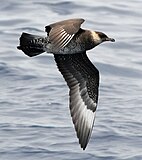 | A passage migrant |
| Arctic skua (Stercorarius parasiticus) | 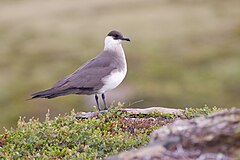 | A passage migrant and localised summer breeder |
| Long-tailed skua (Stercorarius longicaudus) |  | A passage migrant |
Auks, murres, and puffins
Order: Charadriiformes Family: Alcidae
A family of seabirds which are superficially similar to penguins, with their black-and-white colours, upright posture and some of their habits, but which are able to fly.
Tropicbirds
Order: Phaethontiformes Family: Phaethontidae
Tropicbirds are slender white birds of tropical oceans, with exceptionally long central tail feathers. Their heads and long wings have black markings.
| Common and binomial names | Image | Status |
|---|---|---|
| Red-billed tropicbird (Phaethon aethereus) |  | A rare vagrant |
Divers
Order: Gaviiformes Family: Gaviidae
Divers are aquatic birds the size of a large duck, to which they are unrelated. They swim well and fly adequately but are almost helpless on land, because their legs are placed towards the rear of the body. They feed on fish and other aquatic animals.
Southern storm petrels
Order: Procellariiformes Family: Oceanitidae
The southern storm petrels are the smallest seabirds, feeding on plankton and small fish picked from the surface, typically while hovering. They nest in colonies on the ground, most often in burrows.
| Common and binomial names | Image | Status |
|---|---|---|
| Wilson's storm petrel (Oceanites oceanicus) | 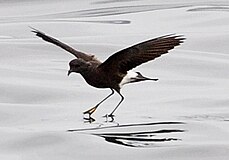 | A rare vagrant, more regularly seen well offshore |
| White-faced storm petrel (Pelagodroma marina) |  | A rare vagrant |
Albatrosses
Order: Procellariiformes Family: Diomedeidae
The albatrosses are among the largest flying birds, with long, narrow wings for gliding. The majority are found in the Southern Hemisphere with only vagrants occurring in the North Atlantic.
| Common and binomial names | Image | Status |
|---|---|---|
| Black-browed albatross (Thalassarche melanophris) | 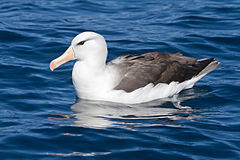 | A rare vagrant |
| Atlantic yellow-nosed albatross (Thalassarche chlororhynchos) |  | A rare vagrant |
Northern storm petrels
Order: Procellariiformes Family: Hydrobatidae
The northern storm-petrels are the smallest seabirds, feeding on plankton and small fish picked from the surface, typically while hovering. They nest in colonies on the ground, most often in burrows.
Shearwaters and petrels
Order: Procellariiformes Family: Procellariidae
These are highly pelagic birds with long, narrow wings and tube-shaped nostrils. They feed at sea on fish, squid and other marine life. They come to land to breed in colonies, nesting in burrows or on cliffs.
Storks
Order: Ciconiiformes Family: Ciconiidae
Storks are large, heavy, long-legged, long-necked wading birds with long stout bills and wide wingspans. They fly with the neck extended.
Frigatebirds
Order: Suliformes Family: Fregatidae
Frigatebirds are large seabirds usually found over tropical oceans. They are large, black-and-white, or completely black, with long wings and deeply forked tails. The males have colored inflatable throat pouches. They do not swim or walk and cannot take off from a flat surface. Having the largest wingspan-to-body-weight ratio of any bird, they are essentially aerial, able to stay aloft for more than a week.
| Common and binomial names | Image | Status |
|---|---|---|
| Ascension frigatebird (Fregata aquila) |  | A rare vagrant |
| Magnificent frigatebird (Fregata magnificens) | 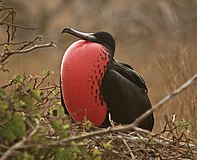 | A rare vagrant |
Boobies and gannets
Order: Suliformes Family: Sulidae
Gannets are large seabirds that plunge-dive for fish and nest in large colonies. They have a torpedo-shaped body, long, narrow, pointed wings and a fairly long tail. There are ten species worldwide with three in Britain.
| Common and binomial names | Image | Status |
|---|---|---|
| Gannet (Morus bassanus) |  | A breeding summer visitor and passage migrant |
| Red-footed booby (Sula sula) |  | A rare vagrant |
| Brown booby (Sula leucogaster) | 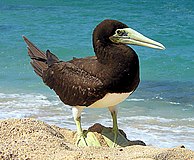 | A rare vagrant, first recorded 2019.[9] |
Cormorants and shag
Order: Suliformes Family: Phalacrocoracidae
Cormorants are medium to large aquatic birds with mainly dark plumage and areas of coloured skin on the face. The bill is long, thin and sharply hooked for catching fish and aquatic invertebrates. They nest in colonies by water, usually by the sea or on the banks of rivers.
Ibises and spoonbills
Order: Pelecaniformes Family: Threskiornithidae
A family of long-legged, long-necked wading birds. Ibises have long, curved bills. Spoonbils have a flattened bill, wider at the tip.
| Common and binomial names | Image | Status |
|---|---|---|
| Glossy ibis (Plegadis falcinellus) |  | A rare vagrant |
| Spoonbill (Platalea leucorodia) |  | A scarce migrant, recently bred |
Bitterns, herons and egrets
Order: Pelecaniformes Family: Ardeidae
Herons and egrets are medium to large wading birds with long necks and legs. Bitterns tend to be shorter-necked and more secretive. They all fly with their necks retracted. The sharp bill is used to catch fish, amphibians and other animals. Many species nest in colonies, often in trees. There are 64 species worldwide and 15 in Britain.
| Common and binomial names | Image | Status |
|---|---|---|
| Bittern (Botaurus stellaris) |  | A resident breeding species and winter migrant |
| American bittern (Botaurus lentiginosus) |  | A rare vagrant |
| Little bittern (Ixobrychus minutus) |  | A scarce migrant, recently bred |
| Least bittern (Ixobrychus exilis) |  | A rare vagrant (first British record[10] pending acceptance by BOU) |
| Night-heron (Nycticorax nycticorax) |  | A scarce migrant, has bred |
| Green heron (Butorides virescens) |  | A rare vagrant |
| Squacco heron (Ardeola ralloides) | 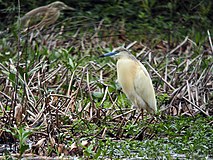 | A rare vagrant |
| Chinese pond heron (Ardeola bacchus) | 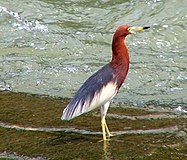 | A rare vagrant |
| Cattle egret (Bubulcus ibis) | 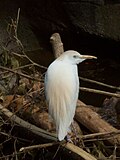 | A scarce but increasing resident, recently bred |
| Grey heron (Ardea cinerea) |  | A resident breeding species and winter migrant |
| Great blue heron (Ardea herodias) |  | A rare vagrant |
| Purple heron (Ardea purpurea) |  | A scarce migrant, recently bred |
| Great white egret (Ardea alba) |  | A resident breeding species, first bred 2012 |
| Snowy egret (Egretta thula) |  | A rare vagrant |
| Little egret (Egretta garzetta) | 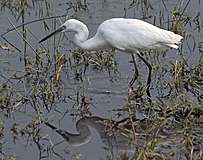 | A resident breeding species and passage migrant |
Pelicans
Order: Pelecaniformes Family: Pelecanidae
Pelicans are large water birds with a distinctive pouch under their beak. As with other members of the order Pelecaniformes, they have webbed feet with four toes.
| Common and binomial names | Image | Status |
|---|---|---|
| Dalmatian pelican (Pelecanus crispus) | 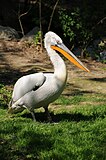 | A very rare migrant[11] |
Osprey
Order: Accipitriformes Family: Pandionidae
A large fish-eating bird of prey belonging to a family of its own. It is mainly brown above and white below with long, angled wings.
| Common and binomial names | Image | Status |
|---|---|---|
| Osprey (Pandion haliaetus) |  | A breeding summer visitor |
Hawks, eagles, and kites
Order: Accipitriformes Family: Accipitridae
A family of birds of prey which includes hawks, buzzards, eagles, kites and harriers. These birds have very large powerful hooked beaks for tearing flesh from their prey, strong legs, powerful talons and keen eyesight.
Barn owls
Order: Strigiformes Family: Tytonidae
Barn owls are medium to large owls with large heads and characteristic heart-shaped faces. They have long strong legs with powerful talons.
| Common and binomial names | Image | Status |
|---|---|---|
| Barn owl (Tyto alba) |  | A resident breeding species |
Owls
Order: Strigiformes Family: Strigidae
Typical owls are small to large solitary nocturnal birds of prey. They have large forward-facing eyes and ears, a hawk-like beak and a conspicuous circle of feathers around each eye called a facial disc.
Hoopoe
Order: Bucerotiformes Family: Upupidae
A small family with a long curved bills, crests and black-and-white striped wings and tails.
| Common and binomial names | Image | Status |
|---|---|---|
| Eurasian hoopoe (Upupa epops) | 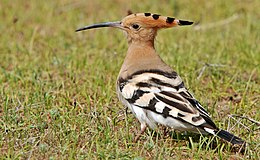 | A scarce summer visitor, occasional breeder |
Rollers
Order: Coraciiformes Family: Coraciidae
A small family of colourful, medium-sized birds with a crow-like shape that feed mainly on insects.
| Common and binomial names | Image | Status |
|---|---|---|
| European roller (Coracias garrulus) | 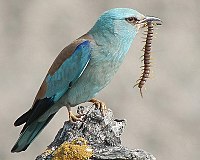 | A rare vagrant |
Kingfishers
Order: Coraciiformes Family: Alcedinidae
Kingfishers are medium-sized birds with large heads, long pointed bills, short legs and stubby tails.
| Common and binomial names | Image | Status |
|---|---|---|
| Kingfisher (Alcedo atthis) |  | A resident breeding species |
| Belted kingfisher (Megaceryle alcyon) | 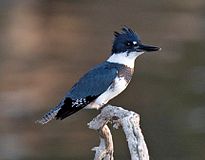 | A rare vagrant |
Bee-eaters
Order: Coraciiformes Family: Meropidae
A group of near-passerine birds characterised by richly coloured plumage, slender bodies and usually elongated central tail-feathers.
| Common and binomial names | Image | Status |
|---|---|---|
| Blue-cheeked bee-eater (Merops persicus) |  | A rare vagrant |
| Bee-eater (Merops apiaster) | 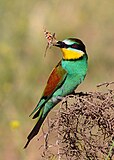 | A scarce summer visitor – occasional breeder |
Woodpeckers
Order: Piciformes Family: Picidae
Woodpeckers are small to medium-sized birds with chisel-like beaks, short legs, stiff tails and long tongues used for capturing insects. Many woodpeckers have the habit of tapping noisily on tree trunks with their beaks.
Falcons and caracaras
Order: Falconiformes Family: Falconidae
A family of small to medium-sized, diurnal birds of prey with pointed wings. They do not build their own nests and mainly catch prey in the air.
Parrots
Order: Psittaciformes Family: Psittaculidae
Parrots are small to large birds with a characteristic curved beak shape. They are found mainly in areas with warm climates.
| Common and binomial names | Image | Status |
|---|---|---|
| Ring-necked parakeet (Psittacula krameri) | 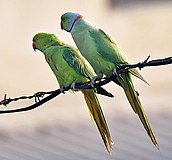 | C resident introduced population |
Tyrant flycatchers
Order: Passeriformes Family: Tyrannidae
A large family from the Americas.
| Common and binomial names | Image | Status |
|---|---|---|
| Eastern phoebe (Sayornis phoebe) |  | A rare vagrant |
| Yellow-bellied flycatcher (Empidonax flaviventris) |  | A rare vagrant, first recorded in 2020.[12] |
| Acadian flycatcher (Empidonax virescens) | 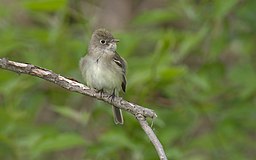 | A rare vagrant |
| Alder flycatcher (Empidonax alnorum) |  | A rare vagrant |
| Eastern kingbird (Tyrannus tyrannus) |  | A rare vagrant |
Shrikes
Order: Passeriformes Family: Laniidae
Shrikes are passerine birds known for their habit of catching other birds and small animals and impaling the uneaten portions of their bodies on thorns. A typical shrike's beak is hooked, like a bird of prey.
Vireos
Order: Passeriformes Family: Vireonidae
The vireos are a group of small to medium-sized passerine birds restricted to the New World.
| Common and binomial names | Image | Status |
|---|---|---|
| Yellow-throated vireo (Vireo flavifrons) |  | A rare vagrant |
| Philadelphia vireo (Vireo philadelphicus) |  | A rare vagrant |
| Red-eyed vireo (Vireo olivaceus) |  | A rare vagrant |
Old World orioles
Order: Passeriformes Family: Oriolidae
The orioles are medium-sized passerines, mostly with bright and showy plumage, the females often have duller plumage than the males The beak is long, slightly curved and hooked. Orioles are arboreal and tend to feed in the canopy. There are 36 species worldwide, one of which has been recorded in Great Britain.
| Common and binomial names | Image | Status |
|---|---|---|
| Golden oriole (Oriolus oriolus) |  | A scarce breeding summer visitor |
Crows, jays, and magpies
Order: Passeriformes Family: Corvidae
The crows and their relatives are fairly large birds with strong bills and are usually intelligent and adaptable.
Waxwings
Order: Passeriformes Family: Bombycillidae
The waxwings are a group of passerine birds characterised by soft, silky plumage and unique red tips to some of the wing feathers.
| Common and binomial names | Image | Status |
|---|---|---|
| Waxwing (Bombycilla garrulus) | 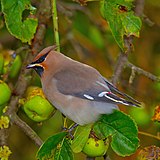 | A winter visitor in highly varied numbers. |
| Cedar waxwing (Bombycilla cedrorum) | 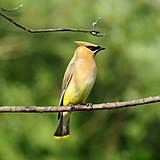 | A rare vagrant |
Tits, chickadees, and titmice
Order: Passeriformes Family: Paridae
Tits are mainly small, stocky, woodland species with short stout bills. They are adaptable birds, with a mixed diet including seeds and insects.
Penduline tits
Order: Passeriformes Family: Remizidae
Small birds with finely pointed bills that build purse-like nests hanging from a branch.
| Common and binomial names | Image | Status |
|---|---|---|
| Penduline tit (Remiz pendulinus) |  | A rare vagrant |
Bearded tit
Order: Passeriformes Family: Panuridae
A single species formerly placed in the Sylviidae family.
| Common and binomial names | Image | Status |
|---|---|---|
| Bearded tit (Panurus biarmicus) |  | A resident breeding species |
Larks
Order: Passeriformes Family: Alaudidae
Larks are small terrestrial birds with often extravagant songs and display flights. Most larks are fairly dull in appearance. Their food is insects and seeds.
Swallows
Order: Passeriformes Family: Hirundinidae
The family Hirundinidae is adapted to aerial feeding. They have a slender streamlined body, long pointed wings and a short bill with a wide gape.
Bush warblers
Order: Passeriformes Family: Cettiidae
A recently split family formerly placed in the Sylviidae family. There are 32 species worldwide, with one found in Britain.
| Common and binomial names | Image | Status |
|---|---|---|
| Cetti's warbler (Cettia cetti) | 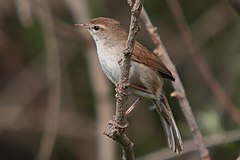 | A resident breeding species |
Long-tailed tits
Order: Passeriformes Family: Aegithalidae
Small, long-tailed birds that typically live in flocks for much of the year. There are 13 species worldwide with one in Britain.
| Common and binomial names | Image | Status |
|---|---|---|
| Long-tailed tit (Aegithalos caudatus) |  | A resident breeding species |
Leaf warblers
Order: Passeriformes Family: Phylloscopidae
A recently split family of small insectivorous birds, formerly included within the Sylviidae. There are 81 species, with 16 in Britain.
Reed warblers
Order: Passeriformes Family: Acrocephalidae
A small, insectivorous and vocal group of species, formerly included within the family Sylviidae.
Grassbirds and allies
Order: Passeriformes Family: Locustellidae
A recently split family, previously part of the family Sylviidae.
Cisticolas and allies
Order: Passeriformes Family: Cisticolidae
A group of insectivorous species, previously included within the family Sylviidae.
| Common and binomial names | Image | Status |
|---|---|---|
| Fan-tailed warbler (Cisticola juncidis) |  | A rare vagrant |
Sylviid warblers, parrotbills, and allies
Order: Passeriformes Family: Sylviidae
A group of small insectivorous birds.
Kinglets
Order: Passeriformes Family: Regulidae
A family of very small birds.
| Common and binomial names | Image | Status |
|---|---|---|
| Ruby-crowned kinglet (Corthylio calendula) |  | A rare vagrant, first recorded in 2020.[13] |
| Goldcrest (Regulus regulus) | 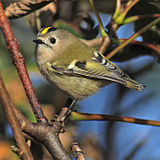 | A resident breeding species |
| Firecrest (Regulus ignicapillus) |  | A scarce resident breeding species and passage migrant |
Wrens
Order: Passeriformes Family: Troglodytidae
Wrens are small and inconspicuous birds, except for their loud songs. They have short wings and thin down-turned bills.
| Common and binomial names | Image | Status |
|---|---|---|
| Wren (Troglodytes troglodytes) |  | A resident breeding species |
Nuthatches
Order: Passeriformes Family: Sittidae
Nuthatches are small woodland birds with the unusual ability to climb down trees head-first, unlike other birds which can only go upwards.
| Common and binomial names | Image | Status |
|---|---|---|
| Red-breasted nuthatch (Sitta canadensis) |  | A rare vagrant |
| Nuthatch (Sitta europaea) |  | A resident breeding species |
Wallcreeper
Order: Passeriformes Family: Tichodromadidae
One species, in its own family, a rare visitor to Britain.
| Common and binomial names | Image | Status |
|---|---|---|
| Wallcreeper (Tichodroma muraria) |  | A rare vagrant |
Treecreepers
Order: Passeriformes Family: Certhiidae
Treecreepers are small woodland birds, brown above and white below. They have thin, pointed, down-curved bills, which they use to extricate insects from bark.
| Common and binomial names | Image | Status |
|---|---|---|
| Treecreeper (Certhia familiaris) | 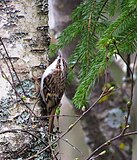 | A resident breeding species |
| Short-toed treecreeper (Certhia brachydactyla) |  | A rare vagrant |
Mockingbirds and thrashers
Order: Passeriformes Family: Mimidae
Medium-sized passerine birds with long tails. Some are notable for their ability to mimic sounds such as other birds' songs.
Starlings
Order: Passeriformes Family: Sturnidae
Starlings are small to medium-sized passerine birds with strong feet. Their flight is strong and direct and most are very gregarious.
| Common and binomial names | Image | Status |
|---|---|---|
| Rose-coloured starling (Pastor roseus) |  | A rare vagrant |
| Starling (Sturnus vulgaris) |  | A resident breeding species and winter visitor |
Thrushes and allies
Order: Passeriformes Family: Turdidae
The thrushes are plump, soft-plumaged, small to medium-sized insectivores or sometimes omnivores, often feeding on the ground. Many have attractive songs.
Old World flycatchers
Order: Passeriformes Family: Muscicapidae. Subfamily: Muscicapinae
The flycatchers and chats are small, mainly insectivorous birds. The flycatchers fly out from a perch to catch insects in the air.
Dippers
Order: Passeriformes Family: Cinclidae
Dark, dumpy, aquatic birds which are able to forage for food on the beds of rivers.
| Common and binomial names | Image | Status |
|---|---|---|
| Dipper (Cinclus cinclus) |  | A resident breeding species |
Old World sparrows
Order: Passeriformes Family: Passeridae
Sparrows tend to be small, plump, brownish or greyish birds with short tails and short, powerful beaks. They are seed-eaters and they also consume small insects.
Accentors
Order: Passeriformes Family: Prunellidae
A small family of drab, unobtrusive, insectivorous birds with thin, pointed bills.
Wagtails and pipits
Order: Passeriformes Family: Motacillidae
Motacillidae is a family of small passerine birds with medium to long tails. They are slender, ground-feeding insectivores of open country.
Finches, euphonias, and allies
Order: Passeriformes Family: Fringillidae
Seed-eating passerine birds that are small to moderately large and have a strong beak, usually conical and in some species very large.
Longspurs and arctic buntings
Order: Passeriformes Family: Calcariidae
A small family of migratory seed eating birds.
| Common and binomial names | Image | Status |
|---|---|---|
| Lapland bunting (Calcarius lapponicus) | 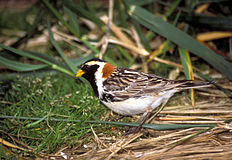 | A winter visitor, occasional breeder |
| Snow bunting (Plectrophenax nivalis) | 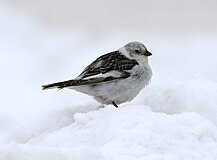 | A winter visitor & scarce breeder |
Old World buntings
Order: Passeriformes Family: Emberizidae. A large group of seed-eating passerine birds with a distinctively shaped bill.
New World sparrows
Order: Passeriformes Family: Passerellidae.
A seed eating group of species, recently split from the family Emberizidae.
Troupials and allies
Order: Passeriformes Family: Icteridae.
The icterids are a group of small to medium-sized, often colorful passerine birds restricted to the New World and include the grackles, New World blackbirds, and New World orioles. Most species have black as a predominant plumage color, often enlivened by yellow, orange, or red.
New World warblers
Order: Passeriformes Family: Parulidae
A group of small, often colourful passerine birds restricted to the New World. Most are arboreal and insectivorous.
Cardinals and allies
Order: Passeriformes Family: Cardinalidae
The cardinals are a family of robust, seed-eating birds with strong bills. They are typically associated with open woodland. The sexes usually have distinct plumages.
The links above lead to family accounts and individual species. Taxonomy is very fluid in the age of DNA analysis, so other arrangements may be found, as in Sibley-Ahlquist taxonomy.
Species awaiting acceptance
The following species have been recorded recently and the British Ornithologists' Union Records Committee has not yet made a decision on whether to accept them onto the British List.
| Common and binomial names | Image | Status |
|---|---|---|
| Paddyfield pipit (Anthus rufulus)[14] | 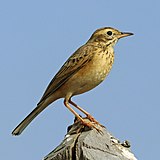 | A rare vagrant, first recorded 2019. |
| Fea's petrel (Pterodroma feae) |  | A rare vagrant, previously accepted onto the British list as Fea's petrel but since split into three distinct species |
| Zino's petrel (Pterodroma madeira) |  | A rare vagrant, first reported 2020.[15] |
| Bearded vulture (Gypaetus barbatus) | 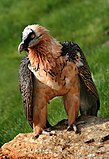 | A rare vagrant, first recorded 2020.[16] |
| Sulphur-bellied warbler (Phylloscopus griseolus) |  | A rare vagrant, first reported 2021.[17] |
See also
- List of non-native birds of Great Britain
- List of birds of Leicestershire and Rutland
- List of birds of Wales
- Lists of birds by region
- British Birds Rarities Committee
- British Birds (a long-established ornithology journal).
- European birds
Footnotes
- British Ornithologists' Union (2013). "The British List". Ibis. 155: 635–676. doi:10.1111/ibi.12069.
- "Maintaining the British List". BOU. Retrieved 4 May 2020.
- BOURC. "Species categories". Retrieved 9 December 2012.
- "The British List". BOU. Retrieved 7 July 2021.
- "Changes to the British List (30 June 2021)". British Ornithologists' Union. 30 June 2021. Retrieved 7 July 2021.
- "Ross's Goose added to Category A of British list". Birdguides. 29 November 2021. Retrieved 2 December 2021.
- Harvey, Robert (2018). "Western Swamphen in Suffolk and Lincolnshire:new to Britain". British Birds. 111 (9): 512–514.
- "South Polar Skua added to British list". Birdguides. 21 August 2021. Retrieved 2 December 2021.
- "Changes to the British List (8 June 2021)". British Ornithologists' Union. 8 June 2021. Retrieved 8 June 2021.
- Viles, Sam (10 October 2022). "Review of the Week: 3-9 October 2022". BirdGuides. Retrieved 10 October 2022.
- "Dalmatian pelican seen 'for first time' in UK at Land's End". BBC News. 11 May 2016. Retrieved 11 September 2020.
- "Yellow-bellied Flycatcher on Tiree". BirdGuides. 25 September 2020. Retrieved 8 December 2020.
- "First Ruby-crowned Kinglet for Britain on Barra". BirdGuides. 23 November 2020. Retrieved 18 January 2021.
- "Paddyfield pipit call identification". The Sound Approach. 6 November 2019. Retrieved 4 May 2020.
- "Zino's Petrel of Scilly – a first for Britain". BirdGuides. 4 August 2020. Retrieved 5 August 2020.
- Birch, Simon (17 July 2020). "Birdwatchers flock to Peak District after rare sighting of bearded vulture in UK". The Guardian. Retrieved 18 July 2020.
- "Sulphur-bellied Warbler in Devon". BirdGuides. 22 June 2021. Retrieved 7 July 2021.
References
- List of British birds published by The British Ornithologists' Union.
- Taxonomic Recommendations for European Birds
- Taxonomic recommendations for British birds (both in PDF format).
- The Royal Society for the Protection of Birds (RSPB) and RSPB A to Z of UK Birds
- Splitting headaches? Recent taxonomic changes affecting the British and Western Palaearctic lists – Martin Collinson, British Birds vol 99 (June 2006), 306–323
- British Trust for Ornithology surveys
Другой контент может иметь иную лицензию. Перед использованием материалов сайта WikiSort.org внимательно изучите правила лицензирования конкретных элементов наполнения сайта.
WikiSort.org - проект по пересортировке и дополнению контента Википедии
